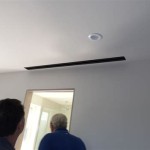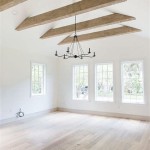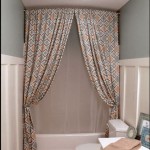Can You Put Crown Molding On a Cathedral Ceiling?
Cathedral ceilings, distinguished by their soaring heights and dramatic angles, offer a sense of grandeur and spaciousness to any room. However, their unique architecture can pose challenges when it comes to interior design, particularly when considering adding decorative elements like crown molding. The question of whether or not crown molding can be successfully installed on a cathedral ceiling is not a simple yes or no. It depends on several factors, including the ceiling's specific configuration, the chosen molding style, and the installer's skill and experience.
Crown molding, traditionally used to bridge the gap between walls and ceilings, adds a touch of elegance and sophistication to a room. Its installation on a standard ceiling is a relatively straightforward process. However, cathedral ceilings present complexities due to their sloping angles and potentially irregular wall-ceiling intersections. These factors necessitate careful planning and execution to ensure a seamless and aesthetically pleasing result. This article will explore the considerations, challenges, and techniques involved in installing crown molding on cathedral ceilings.
Addressing the Angle Issue: Mitering and Coping
The primary challenge in installing crown molding on a cathedral ceiling lies in adapting the molding to the non-standard angles created by the sloping ceiling and vertical walls. Unlike a standard 90-degree intersection, cathedral ceilings typically feature angles ranging from shallow to steep. Accurately measuring and cutting the molding to perfectly fit these angles is crucial for a professional finish. Two common techniques are employed to address this challenge: mitering and coping.
Mitering involves cutting the molding at precise angles using a miter saw. The angles are calculated based on the specific angle of the ceiling. For example, if the ceiling angle is 45 degrees, the molding pieces need to be mitered at half that angle (22.5 degrees). While mitering is a relatively straightforward technique for simple angles, it becomes more complex when dealing with irregular or compound angles. In such cases, precise measurements and calculations are essential to avoid gaps or overlaps at the joints. Any slight error in measurement or cutting can result in a visible imperfection, detracting from the overall aesthetic.
Coping, on the other hand, involves creating a profile on the end of one piece of molding that precisely matches the profile of the adjoining piece. This technique is particularly useful for inside corners and when dealing with walls that are not perfectly square. The process involves cutting one piece of molding square (using a miter saw or coping saw), then using a coping saw or a similar tool to carefully remove material from the back of the molding, leaving only the profile. This profile is then fitted against the adjacent piece of molding, creating a seamless joint.
Coping offers several advantages over mitering. It is more forgiving of slight variations in wall angles and can create a tighter, more durable joint. Additionally, coping is less prone to opening up over time due to seasonal changes in temperature and humidity, which can cause wood to expand and contract. While coping requires more skill and patience than mitering, it is often the preferred method for achieving a professional-looking finish on cathedral ceilings, especially in situations where the angles are complex or irregular.
Selecting the Right Molding Profile and Material
The choice of molding profile and material is another crucial factor to consider when installing crown molding on a cathedral ceiling. The profile, or shape, of the molding can significantly impact the overall aesthetic of the room. Simpler, less ornate profiles tend to work well in contemporary or minimalist spaces, while more elaborate profiles can complement traditional or formal decor. The size of the molding should also be proportionate to the size of the room and the height of the ceiling. A small, delicate molding may get lost in a large room with a high cathedral ceiling, while an overly large molding can overwhelm a smaller space.
The material of the molding is equally important. Common options include wood, MDF (medium-density fiberboard), and polyurethane. Wood molding offers a classic, high-end look and can be stained or painted to match the room's decor. However, wood is susceptible to moisture damage and can warp or crack over time, especially in humid environments. MDF is a more affordable alternative to wood and is less prone to moisture damage. It is also easier to work with than wood, as it can be cut and shaped with common woodworking tools. However, MDF is not as durable as wood and can be damaged by impact.
Polyurethane molding is a synthetic material that is lightweight, durable, and resistant to moisture, insects, and rot. It is also easy to install and can be painted to match any color scheme. Polyurethane molding is a good option for bathrooms, kitchens, or other areas where moisture is a concern. It is also a good choice for intricate molding profiles, as it can be molded into complex shapes with sharp details. When selecting the molding material, consider the room's style, the budget, and the environmental conditions.
Installation Techniques and Support Considerations
Proper installation techniques are essential for ensuring the crown molding is securely attached to the walls and ceiling. This is especially important on cathedral ceilings, where the sloping angles can create additional stress on the molding. The first step is to accurately measure and mark the locations where the molding will be installed. Use a level and a long straightedge to ensure the molding is installed straight and level. When installing the molding, use construction adhesive and finish nails to attach it to the walls and ceiling.
Construction adhesive provides a strong bond between the molding and the wall or ceiling, while finish nails hold the molding in place until the adhesive dries. Use a nail gun to drive the finish nails into the molding. Be careful not to overdrive the nails, as this can damage the molding. Space the nails evenly along the length of the molding, typically every 12 to 16 inches. For longer runs of molding, it may be necessary to use additional support, such as blocks of wood or temporary bracing. These supports will help to prevent the molding from sagging or pulling away from the wall or ceiling.
Another consideration is the type of wall and ceiling material. Drywall, plaster, and wood all require different types of fasteners. For drywall, use drywall anchors or screws. For plaster, use plaster screws or nails. For wood, use finish nails or screws. When installing crown molding on a cathedral ceiling, it is also important to consider the weight of the molding. Heavy molding may require additional support to prevent it from pulling away from the wall or ceiling. In such cases, consider using larger fasteners or adding additional blocks of wood behind the molding for support. The goal is to create a secure and long-lasting installation that will withstand the test of time.
In conclusion, the installation of crown molding on a cathedral ceiling is a feasible but complex undertaking. The success of the project hinges on meticulous planning, accurate measurements, precise cutting techniques, and the selection of appropriate materials and installation methods. Careful consideration of the room's specific architectural features, combined with a skilled approach, can result in a stunning and visually appealing addition to the space.

How To Install Crown Molding On Vaulted Or Cathedral Ceilings The Joy Of Moldings

How To Install Crown Molding On A Vaulted Cathedral Ceiling Without Transition Piece

Installing Crown Molding Around A Cathedral Ceiling Fine Homebuilding

Crown Molding On Angled Ceilings Makely

How To Install Crown Molding On Vaulted Or Cathedral Ceilings The Joy Of Moldings

Installing Crown Molding On A Vaulted Ceiling Pro Construction Guide

Can You Put Crown Molding On A Vaulted Ceiling Hometalk

How To Install Crown Molding On Vaulted Or Cathedral Ceilings Ceiling Living Room High

Installing Crown Moulding Part Two Canadian Woodworking

Install Crown Molding Cathedral Vaulted Ceiling
Related Posts








